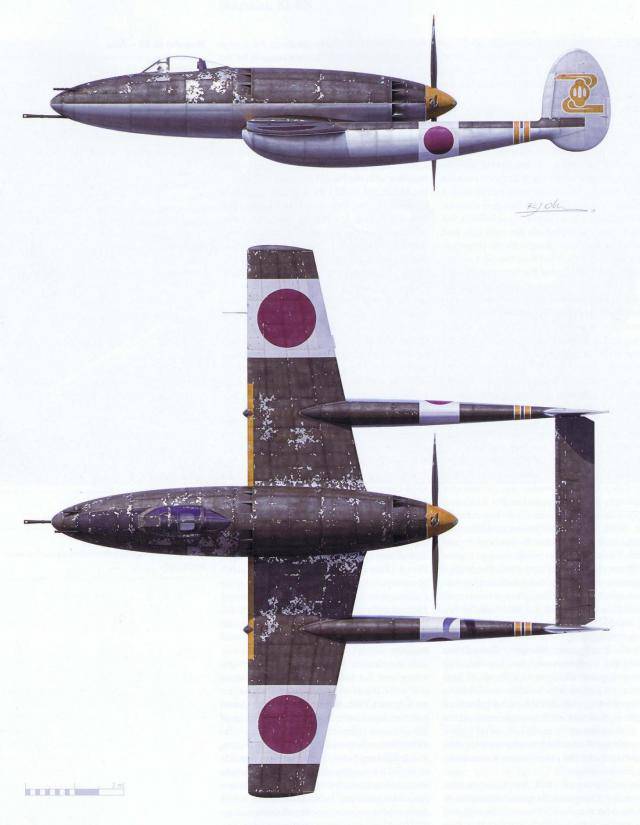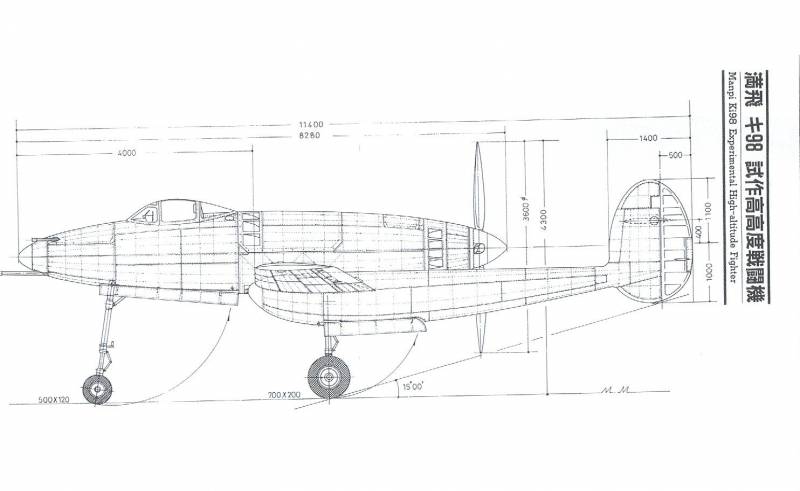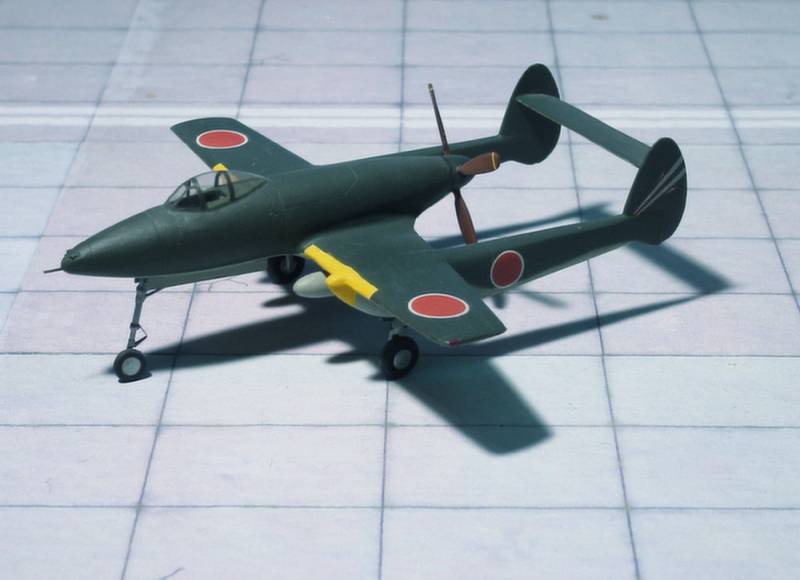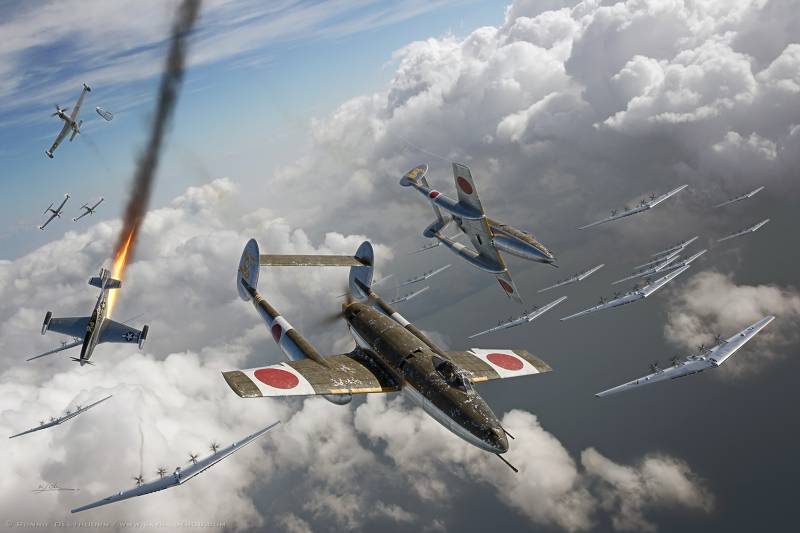Project Ki-98 multipurpose fighter
The search for promising new combat aircraft designs to further replace the aging aircraft fleet that was in service began in Japan at the end of the 1942 year. A special place was given to the creation of a high-altitude fighter-interceptor and a heavy fighter-attack aircraft. Nakajima and Tachikawa companies were asked to create an interceptor fighter, their development transformed into Ki-87 and Ki-94 projects, respectively. At the same time, the military drew on the Kawasaki Ki-102 multi-role fighter project, while the proposed project was not considered as an undisputed winner. The competition for Kawasaki was to be made by the small aircraft manufacturing company Manshukoku Hikoki Seizo KK, better known as Manshu, from the puppet pro-Japanese state of Manchukuo.
The main plant of Manshu was located in Harbin, the capital of Manchukuo. Manshu was founded only in 1938 year and was a subsidiary of Nakajima Hikoki KK. In Harbin, the famous Ki-27 fighter was produced under license, and later Nakajima developed by Ki-84. There were also their own developments here, in particular, the mass-produced training aircraft of increased flight training Ki-79, which was created on the basis of the Ki-27 fighter. To work on a promising multi-role fighter in Harbin attracted their best shots.
As a result, the Manshu designers presented an unusual design of an aircraft with an unconventional layout - it was a single-seat fighter with a double-girder design with a pusher propeller. A thin wing was installed in a low-profile configuration; there was a beam on each console, which ended with an egg-shaped vertical plumage. A single high mounted horizontal tail tied two fighter tails. The chassis of the Ki-98 fighter was three-pronged. The nose landing gear was retracted into a niche located under the aircraft cabin. Each of the two main landing gear was retracted into the corresponding tail boom.
The plane was planned to be equipped with a powerful 18-cylinder radial air-cooled engine Mitsubishi Ha-211-III, which developed maximum power - 2200 hp. Located in the rear part of the aircraft fuselage, the four-bladed propeller was set in motion by means of an elongated shaft 2 meter long. In order to preserve the flow around the fuselage, the Japanese designers did not use air intakes, instead of them in the upper part of the multi-purpose fighter's fuselage behind the lantern's lamp were located hidden inlets. In order to increase the flow of air to the power plant, a fan was provided, which was driven by the engine of the aircraft.
Since the cockpit was located rather high above the ground, access to it was made through a niche of the nose gear. The pilot's cockpit lantern was drop-shaped and provided the pilot with an excellent overview. In the event of an emergency on board, the pilot had two options: he could leave the plane in the usual way through a drop cockpit canopy, but in this case he was almost guaranteed to meet the screw and stabilizer at the back with the most disastrous consequences for himself. The company Manshu recommended pilots to leave the plane through the hatch, located at the bottom of the aircraft. This allowed the pilot to avoid meeting with the stabilizer, but still had a chance to get into the screw. The chances of surviving the pilot were slim, and the Manshu company knew about this design flaw.
The Ki-98 multipurpose fighter was supposed to receive powerful enough weapons, which consisted of two 20-mm No-5 aircraft cannons and one Ho-37 204-mm cannons. All three guns were concentrated in the nose of the central gondola fighter. At the same time, their trunks came forward strongly due to the relatively short fuselage of the gondola, as well as the lack of space. A curious detail is that the Ho-37 Japanese 204-mm gun was based on the design of the American Browning 12,7-mm heavy machine gun. Aircraft gun Ho-204 has become the largest system built on the basis of this American machine gun.
The projectile fired from the Ho-204 aircraft cannon had kinetic energy of only 120 kJ, which was commensurate with the American M10 and M4 cannons and significantly less than the Soviet NS-37, German BK-3.7 or American M9. However, the practical rate of fire was almost 400 shots per minute, it was inherited from the heavy machine gun Browning. According to this indicator, the Ho-204 cannon is about 2-2,5 several times larger than all the 37-mm systems listed above. In addition, the long barrel provided very good ballistics. Due to the combination of these parameters, the Japanese aviation artillery system could be called the best in its class. However, the problems that were characteristic of Japanese industry at the final stage of the war did not allow organizing the mass production of this artillery system, as well as the quality level of production.
The working draft of the Ki-98 multipurpose fighter was completed by July 1943. After that, in Harbin, the construction of a full-scale wooden model was started, which was ready in December of the same year. In order to make some modifications in the design, the design work continued at the beginning of 1944, and the wooden model of the aircraft was sent to Japan, where it was to be tested in a wind tunnel. The deterioration of the military situation for Japan was the reason that a part of the Manshu employees were transferred to other jobs that were related to the establishment of production of mass-produced aircraft, or changed their line of business. All of this slowed down the process of creating the Ki-98 fighter. Despite this, tests carried out in Japan showed excellent results, so Manshu began to prepare the construction of the prototype.

In the spring of 1944 of the year, the Chief Command of the Army Aviation of Japan instructed the leadership of Manshu to adapt the Ki-98 aircraft to the role of a high-altitude fighter. Because of this, the designers of the company from Harbin were forced to change the design of their aircraft to the new requirements of the military, which further slowed down the general course of work. One of the most important changes was the need to use an aircraft engine with a turbocharger, as a result of which the Ha-211-III had to replace the large-sized Mitsubishi Ha-211 Ru engine.
Mitsubishi Ha-211 Ru is a high-rise version of the engine, equipped with a turbocharger. The engine weighed a little less than a ton and, in terms of power unit to unit mass, was supposed to be the most efficient in the world at that time. However, in the pursuit of minimizing the size and weight of the Ha-211 engine, Mitsubishi’s designers made a mistake in heat removal from the cylinders. Two rows of cylinders were too tightly clamped, as a result, the engine was constantly overheating. He repeated the fate of the Soviet M-71 aircraft engine. Until the end of World War II, Japanese engineers did not succeed in achieving stable operation of this engine.
The new engine was more than the originally planned Ha-211-III, so the designers had to expand and lengthen the fuselage of the Ki-98. Since a new screw of larger diameter was used, the tail beams had to be pulled apart from each other. As a result, the wings of the aircraft were redesigned. Finally, the fighter glider was strengthened due to the increased mass of the structure. Another change was to facilitate the process of the pilot leaving the plane in the event of an emergency. It was decided not to leave the plane through the nose landing gear compartment. In this case, the design of the aircraft included explosive bolts designed for the emergency shooting of propeller blades, as well as tail. Thanks to this, the pilot could leave the plane in an extreme situation in the traditional way through a hinged canopy. The aircraft’s armament was decided to remain unchanged, since it met the tasks of the struggle with the American bombers, which it was to intercept.
The redesigned multi-role fighter was ready for October 1944. After that, a new stage of prototyping the redesigned aircraft fuselage began. According to the plans, the plane was supposed to be ready and start a flight test program at the beginning of the 1945 of the year, but they were buried by the bombings of Harbin, which the Americans conducted the 7 of December of 1944 of the year. For this reason, work on the construction of the Ki-98 was able to resume only in the middle of January 1945. Despite all attempts to accelerate the pace of work, it was not possible to catch up with the planned dates.
By August, 1945, the fuselage, tail beams and aircraft wing were ready, they were ready for assembly. But 8 August 1945, the Soviet Union declared war on Japan, and the next day Soviet troops entered the territory of the state of Manchukuo. The Manchu imperial and Japanese Kwantung armies were unable to resist the Soviet troops and stop their advancement. For this reason, the company Manshu decided to destroy all the mock-ups, equipment, tools, the unfinished Ki-98 fighter, as well as the technical documentation on the project, so that all this does not fall into the hands of Soviet specialists.
Flight technical characteristics of the Ki-98 (design):
Overall dimensions: length - 11,39 m, height - 4,29 m, wing span - 11,24 m, wing area - 23,99 m2.
Empty weight - 2880 kg.
Normal take-off weight - 3500 kg.
The power plant is a Mitsubishi Ha-211 Ru engine with 2200 horsepower.
The maximum flight speed is 731 km / h.
Cruising speed - 654 km / h.
Practical range - 1000 km.
Practical ceiling - 12 000 m.
Armament - 1X37-mm gun Ho-204 and 2-X20-mm gun Ho-5.
Crew - 1 man.
Information sources:
http://www.airwar.ru/enc/aww2/ki98.html
http://alternathistory.com/istrebitel-shturmovik-98-manshu-mansyu-ki-98-yaponiya
http://airspot.ru/catalogue/item/mansyu-ki-98



Information